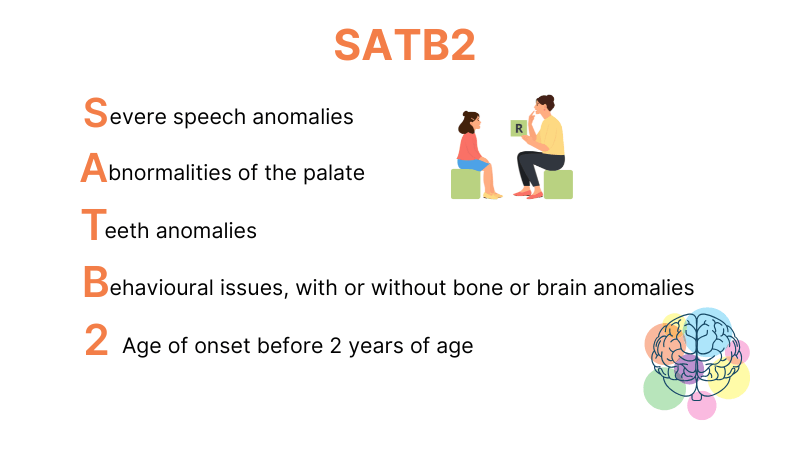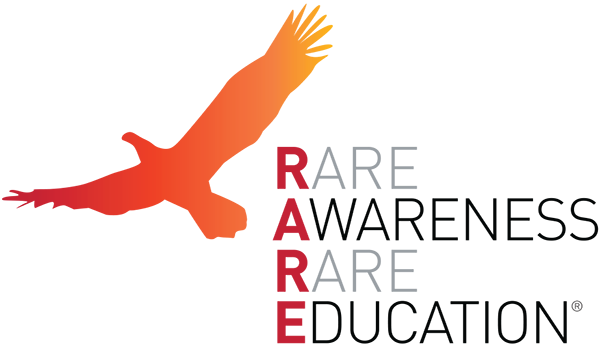SATB2 Associated Syndrome
Quick Search
- Summary
- Synonyms and Classifications
- Symptoms
- Disability Impacts
- Cause and Inheritance
- Diagnosis
- Treatment
- Clinical Care Team
- Clinical Care Guidelines
- Emergency Management
- Research
- Rare Disease Organisation(s)
- Lived Experience
- Support Services and Resources
- Mental Health
- Other Information
- Useful Links for Healthcare Professionals
Summary
SATB2 Associated Syndrome is a genetic condition that affects multiple body systems (multisystem condition) and is present from birth (congenital).1 It is characterised by developmental delay, intellectual disability with limited or no speech, certain behavioural attributes, and differences of the teeth and/ or palate (roof of the mouth).1-3 Other features include low muscle tone (hypotonia), feeding difficulties, and differences in the skeletal system including low bone mineral density with an increased risk of fractures. Some individuals also have seizures.1,2
‘SATB2’ can be used as an acronym to describe some of the common features:1,5
SATB2 Associated Syndrome is caused by genetic changes (variants) in the SATB2 gene.1,4 These genetic variants typically occur randomly (de novo) before birth, and are rarely inherited. Both males and females can have a diagnosis of SATB2 Associated Syndrome. Management of the condition involves a multidisciplinary medical team and care is often life-long.1

Synonyms and Classifications
Synonyms: 2q33.1 microdeletion syndrome; Glass syndrome; SAS.

Universal rare disease classifications provide a common language for recording, reporting and monitoring diseases. Please visit the Rare Disease Classifications page for more information about these internationally recognised classifications.
ORPHA:576278 SATB2-associated syndrome
There is no ICD-11 classification.
Symptoms
Common features of SATB2 Associated Syndrome include, but are not limited to, the following:1-8
- developmental delays
- intellectual disability with limited or no speech
- palate abnormalities such as cleft palate (opening in the roof of the mouth), high-arched palate (roof of the mouth is higher and more narrow than usual) and bifid uvula (uvula that is forked or split into two)
- teeth differences
- jovial or friendly personality
- behavioural attributes such as hyperactivity, anxiety, impulsivity and features on the autism spectrum
- sleep issues
- feeding difficulties
- low muscle tone (hypotonia)
- seizures and/ or epilepsy
- skeletal differences such as scoliosis (sway to the spine), tibial bowing (a bent appearance to the lower part of the leg bone), and joint contractures (stiffening of the joints), with low bone density
- a range of differences on neuroimaging (imaging of the brain and other parts of the central nervous system) have been described
Further information about the clinical description of SATB2 Associated Syndrome can be found at GeneReviews®: SATB2-Associated Syndrome (Clinical Characteristics section).1
Please speak to your medical team to learn more about the features and health implications associated with SATB2 Associated Syndrome.
Disability Impacts
Rare diseases are often serious and progressive, exhibiting a high degree of symptom complexity, leading to significant disability. Majority of the estimated two million Australians living with a rare disease meet the Australian Government’s definition for disability (in accordance to the Australian Public Service Commission and Australian Bureau of Statistics), and many experience severe and permanent disability impacts. If you or someone you care for is experiencing disability-related impacts from a rare condition, please speak with a health or disability professional for advice. Information about relevant disability support can be found at the RARE Portal’s Disability Support Information page.
Cause and Inheritance
SATB2 Associated Syndrome is a genetic condition caused by disease-causing genetic changes (variants) in the SATB2 gene on Chromosome 2. These genetic variants include single base changes (sequence variants/ a single letter changes in the genetic code), deletions, duplications, as well as large chromosomal rearrangements and translocations that span the SATB2 locus.4 For more information on different types of genetic variants, please refer to Centre for Genetics Education: Types of genetic variation.
All individual have two copies (alleles) of the SATB2 gene, one on each chromosome inherited from each parent. SATB2-associated syndrome is an autosomal dominant condition – a genetic variant in just one of the SATB2 gene copies can result in SATB2 Associated Syndrome.1
For most individuals with SATB2 Associated Syndrome, their genetic variant in SATB2 occurs randomly (de novo) prior to birth and is not passed down (inherited) from their parents. In a small number of reported families, the genetic variant in one of the SATB2 alleles had been inherited from a parent who has the genetic change in some but not all of their cells (this is called genetic mosaicism); the parent often has typical learning abilities and health.1,4 More information on genetic mosaicism can be found at Centre for Genetics Education: Mosaicism.
If you would like to learn more about the inheritance and impact of this condition, please ask your doctor for a referral to a genetic counsellor. Genetic counsellors are qualified allied health professionals who can provide information and support regarding genetic conditions and testing. More information about genetic counselling can be found at:
- Information on Genetic Services
- The National and State Services pages underneath the ‘Genetic Counselling’ sections listed
Diagnosis
There are no formal clinical diagnostic criteria established for SATB2 Associated Syndrome.1 A diagnosis of SATB2 Associated Syndrome may be suspected based on certain clinical characteristics and confirmed by genetic testing.
More information about clinical characteristics, including when a diagnosis of SATB2 Associated Syndrome may be suspected, can be found at GeneReviews®: SATB2-Associated Syndrome (under Diagnosis).1
Genetic testing may firstly involve chromosomal microarray analysis (CMA), and if that is not diagnostic exome or genome sequencing may be used, to identify genetic changes in the SATB2 gene.1 General information about these genetic tests can be found at:
- Pathology Tests Explained: Genome-wide chromosome microarray testing
- Pathology Tests Explained: Whole Genome or Whole Exome Testing for Childhood Syndromes
A differential diagnosis can rule out other condition that have similar symptoms, such as KBG syndrome and Angelman syndrome.1
Please speak to your medical team to learn more about the available diagnostic pathways for SATB2 Associated Syndrome.
Treatment
There is currently no curative treatment for SATB2 Associated Syndrome. Treatment is targeted at symptomatic management, reduce complications and improve quality of life, and involves a multidisciplinary care team. This may include speech and language therapy, physiotherapy, occupational therapy, feeding therapy and use of assistive equipment as well as augmentative and alternative communication (AAC) tools.1,6 Surgery may be required for a cleft palate.6
Please speak to your medical team to learn more about the possible treatment or management options for your condition. Treatment will depend on an individual’s specific condition and symptoms. It is also important to stay connected to your medical team so that you can be made aware of any upcoming clinical trial opportunities.
Clinical Care Team
Healthcare professionals involved in the treatment of SATB2 Associated Syndrome may include general practitioners (GP), paediatricians, geneticists, cardiologists, neurologists, ENT specialists, dentists, speech therapists, psychologists, occupational therapists, physiotherapists, social workers, and behavioural therapists.5 The need for different healthcare professionals may change over a person’s lifetime and extend beyond those listed here.
Clinical care for rare diseases often involves a multidisciplinary team of medical, care and support professionals. Please note that the information provided here is as a guide and that RVA does not necessarily monitor or endorse specific clinics or health experts.
For many rare diseases, palliative care services may be relevant and useful. Palliative care services are available for people (adults, children and their families) living with a life-limiting illness. Palliative care services provide assistance, support, resources and tools to help people manage their illness and the symptoms, ease pain, and improve comfort and quality of life. Palliative care is not only for end-of-life care. It can also help at any stage of illness from diagnosis onwards, and will look different for different people. For more information about palliative care and how it can help you, please visit:
Healthcare professionals involved in the treatment of SATB2 Associated Syndrome may include general practitioners (GP), paediatricians, geneticists, cardiologists, neurologists, ENT specialists, dentists, speech therapists, psychologists, occupational therapists, physiotherapists, social workers, and behavioural therapists.5 The need for different healthcare professionals may change over a person’s lifetime and extend beyond those listed here.
Clinical Care Guidelines
We are not aware of any clinical care guidelines for SATB2 Associated Syndrome in Australia. If you know of any relevant care guidelines, please let us know via the Contribute page.
The following guidance is available from international experts outside Australia; however, there may be information that is not relevant or applicable to the Australian context, and may not be up to date:
GeneReviews®: SATB2-Associated Syndrome (Management section) includes recommendations on evaluations, treatment and surveillance, based on experience managing individuals with SATB2 Associated Syndrome
Emergency Management
Individuals living with rare diseases may have complex medical issues and disabilities, which are not always visible. It is often useful to refer to their medical history as well as personal information such as a medical card, doctor’s letter, or if available, a rare disease passport, for relevant information.
It may be important to consider the following when managing individuals living with SATB2 Associated Syndrome at emergency departments/services:
- will need 24/7 attendant/carer support in Emergency and Hospital, regardless of age
- may not be able to communicate with spoken words and may use alternative communication methods such as key word sign, sign language or Alternative and Augmentative Communication tools and devices
- may have emotional regulation difficulties
- may have a high pain threshold
- may have seizures
- may have feeding difficulties
- may have continence issues
Research
Exploring the health, education and social support needs of individuals diagnosed with SATB2 Associated Syndrome and their families living in Australia is an Australian research study that utilises a co-design research approach with Australian families supporting their loved ones diagnosed with SATB2 Associated Syndrome.
SATB2 Connect: SATB2 Research has more information about Australian research collaborations for SATB2 Associated Syndrome.
There are specific considerations around participating in rare disease research, including clinical trials. It is important to be mindful of issues such as data privacy, research ethics, consent and differences in research regulations between Australia and other countries.
If you are interested in finding clinical trials for your condition, please visit the following websites; however, there may not be any clinical trials available:
It is best to discuss your interest in any clinical trials with your medical team to determine suitability and eligibility.
Rare Disease Organisation(s)
Australian Organisation:
SATB2 Connect
Website: https://satb2.org.au/
SATB2 Connect aims to advocate, raise awareness and educate about SATB2 Associated Syndrome, including professionals through research.
Please note that RVA does not monitor or endorse each group/organisation’s operational governance and activities. When engaging with a group, please consider the information on the RARE Portal’s Finding Helpful Peer and Community Supports page.
Lived Experience
SATB2 Associated Syndrome varies between individuals, and each person’s experience is unique.
Please visit SATB2 Connect: Family Stories to read the personal stories of families living with SATB2 Associated Syndrome.
If you would like to share your personal story with RVA, please visit the Rare Voices Australia: Share Your Story page. RVA will consider your story for publishing on our website and inclusion on the RARE Portal.
Support Services and Resources
SATB2 Connect has support resources for parents/caregivers, including a parent’s roadmap that has information to help parents and caregivers understand more about diagnosis ofSATB2 Associated Syndrome, prepare for paediatric appointments, navigate the NDIS as well as the education system.
For information on available government and social services that provide support for individuals with a rare disease, please visit the National and State Services pages.
Mental Health
People living with a rare disease, including families and carers, often face unique challenges such as diagnostic delays, misdiagnoses, limited treatment options, and limited access to rare disease specialists and support. These challenges may impact people’s emotional wellbeing and quality of life. Many people find it helpful to seek mental health and wellbeing support to cope with ongoing stress and uncertainty. Connecting with people who have shared experiences through a support group may also be helpful. Information about relevant mental health and wellbeing support can be found at:
- Mental Health and Wellbeing Support for Australians Living with a Rare Disease
- The National and State Services pages underneath the ‘Mental Health’ sections listed
Other Information
Further information on SATB2 Associated Syndrome can be found at:
Useful Links for Healthcare Professionals
References
- Zarate YA, Bosanko K, Fish J. SATB2-Associated Syndrome. 2017. Updated 20 June 2024. In: Adam MP, Mirzaa GM, Pagon RA, et al. GeneReviews® [internet]. Seattle (WA): University of Washington Seattle. 1993–. Accessed 26 November 2024. https://www.ncbi.nlm.nih.gov/books/NBK458647
- Online Mendelian Inheritance in Man (OMIM). #612313 Glass Syndrome. 2008. Updated 18 August 2023. Accessed 26 November 2024. https://omim.org/entry/612313
- Genetic and Rare Diseases (GARD) Information Center. SATB2-associated syndrome. https://rarediseases.info.nih.gov/diseases/22326/satb2-associated-syndrome
- Zarate YA, Bosanko KA, Caffrey AR, et al. Mutation update for the SATB2 gene. Hum Mutat. 2019; 40(8): 1013-1029. http://doi.org/10.1002/humu.23771
- SATB2 Connect. What is SATB2? Sydney; 2022. 1p. https://satb2.org.au/wp-content/uploads/2023/03/1.-What-is-SATB2.pdf
- Thomason A, Pankey E, Nutt B, et al. Speech, language, and feeding phenotypes of SATB2-associated syndrome. Clin. Genet. 2019; 96(6): 485-492. https://doi.org/10.1111/cge.13619.
- Cotton AP, Gokarakonda S, Caffrey AR, et al. Behavioral phenotype and sleep problems in SATB2-associated syndrome. Dev. Med. Child. Neurol. 2020; 62: 827-832. https://doi.org/10.1111/dmcn.14330
- Bissell S, Oliver C, Moss J, et al. The behavioural phenotype of SATB2-associated syndrome: a within-group and cross-syndrome analysis. J. Neurodevelop. Disord. 2022; 14:25. https://doi.org/10.1186/s11689-022-09426-0
Contributors
This page has been co-developed by Rare Voices Australia (RVA)’s RARE Portal team in consultation with SATB2 Connect.
If you are aware of any additional information that may benefit stakeholders with an interest in this page, or if you notice any broken links or inaccurate information, please let us know via the Contribute page.

